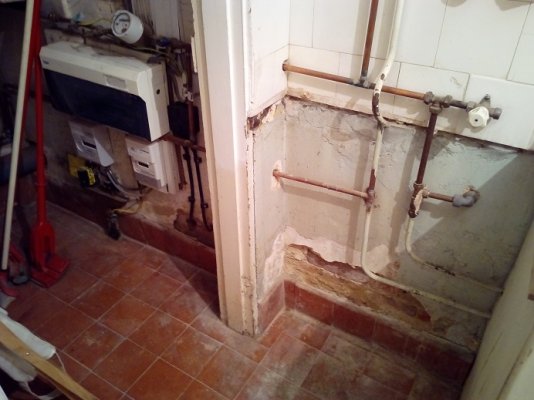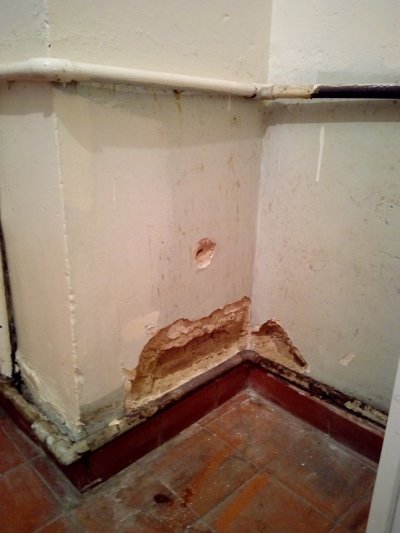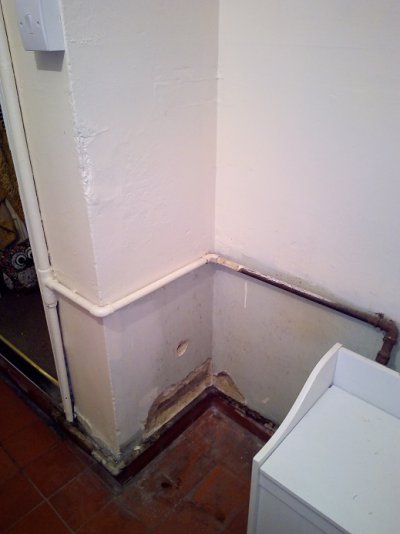parkview094
Member
- Messages
- 149
- Location
- Hersham, Surrey
We have finally saved up enough money to start Phase I of putting a 'proper' kitchen into our home.
Clearing out what used to be the Scullery on the weekend, I discovered a couple of areas where the lime plaster was just crumbling away. Scraping away the loose stuff, the brickwork looks and feels dry underneath. The plaster is powdery and certainly not damp to the touch. Have read the various existing damp threads on the forum, so really just wanted a quick sanity check of my logic..

There is a section along the bottom of the (inside of an) external wall. The ground levels on the other side are all original and well beneath the original slate DPC, but there is a drain here which takes both rainwater from the roof (3 storeys up) as well as the bathroom and temporary kitchen wastes, so I suspect this is historic as the drain was blocked when we moved in 2 years ago.

The other section is in the corner of the room on an entirely internal wall. The gas pipe that runs round the base of the wall is quite corroded where the plaster has come off, so it has clearly been wet here for some time. Again, however, scraping all the loose stuff off, everything seems to be dry underneath. Before we bought the house, it stood empty for just over a year and for many years before that the scullery was just used as a utility room with a tumble drier. There is no heating in the room and the floor is quarry tile on concrete. My thinking is that probably the temperature extremes and or "stray condensation" from the tumble drier probably built up over the years and collected at the base of the wall.
As everything now seems dry and the remaining plaster is solid, my plan was going to be:
Lime plaster over the damaged bits, skim all the walls so they're smooth and then paint. The plan is to turn this space into a proper utility room, so I was thinking about installing a small radiator to keep the room warmer. Does this sound like a reasonable approach, or is there something else I should check/do?
One thing that was nagging me slightly with re-skimming the walls is that they seem to have been painted in a high-sheen paint. It's hard to see from the photo's but the finish is almost eggshell..

My gut feel is it may be the original paint from when the house was built as the kitchen? is in exactly the same finish. When I was scaping the loose plaster away, there didn't seem to be any evidence of any other layers of paint beneath... is that a needless worry?
Clearing out what used to be the Scullery on the weekend, I discovered a couple of areas where the lime plaster was just crumbling away. Scraping away the loose stuff, the brickwork looks and feels dry underneath. The plaster is powdery and certainly not damp to the touch. Have read the various existing damp threads on the forum, so really just wanted a quick sanity check of my logic..

There is a section along the bottom of the (inside of an) external wall. The ground levels on the other side are all original and well beneath the original slate DPC, but there is a drain here which takes both rainwater from the roof (3 storeys up) as well as the bathroom and temporary kitchen wastes, so I suspect this is historic as the drain was blocked when we moved in 2 years ago.

The other section is in the corner of the room on an entirely internal wall. The gas pipe that runs round the base of the wall is quite corroded where the plaster has come off, so it has clearly been wet here for some time. Again, however, scraping all the loose stuff off, everything seems to be dry underneath. Before we bought the house, it stood empty for just over a year and for many years before that the scullery was just used as a utility room with a tumble drier. There is no heating in the room and the floor is quarry tile on concrete. My thinking is that probably the temperature extremes and or "stray condensation" from the tumble drier probably built up over the years and collected at the base of the wall.
As everything now seems dry and the remaining plaster is solid, my plan was going to be:
Lime plaster over the damaged bits, skim all the walls so they're smooth and then paint. The plan is to turn this space into a proper utility room, so I was thinking about installing a small radiator to keep the room warmer. Does this sound like a reasonable approach, or is there something else I should check/do?
One thing that was nagging me slightly with re-skimming the walls is that they seem to have been painted in a high-sheen paint. It's hard to see from the photo's but the finish is almost eggshell..

My gut feel is it may be the original paint from when the house was built as the kitchen? is in exactly the same finish. When I was scaping the loose plaster away, there didn't seem to be any evidence of any other layers of paint beneath... is that a needless worry?
